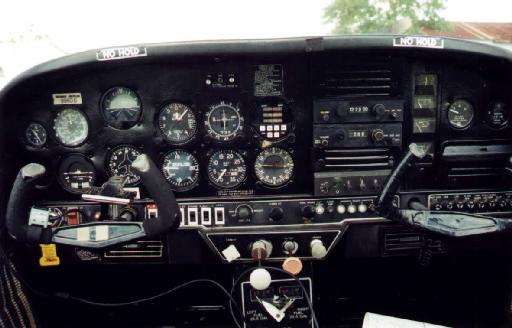
The Grummun AA5A Tiger parked at Weiser Air Park
| GRUMMAN-AMERICAN AA5 SERIES |
|---|

The Grumman series has a reputation for being a little sportier than the average spam-can. As a result of our club's Cessna 170 having an engine rebuild, I flew this Cheetah from Houston Hobby to Pinckneyville, Illinois, quite a long cross country.
| -- Checking out -- |
|---|
Fletcher at Houston Hobby is kind of Grumman Central. They sell Grummans, Grumman parts, and are a Part-141 flight school, teaching mainly in the Grumman series. Importantly for me, they had one free the entire weekend for my long trip to the rec.aviation flyin.
I got checked out in an AA5B (Tiger), which is basically the same as the Cheetah, but with a 180-horsepower O-360 instead of the Cheetah's 150-horsepower O-320. Preflight turned out to be conventional. The Grumman has 4 fuel sumps instead of the usual three I've found on everything else I've flown so far. The other difference you notice on close examination is the lack of rivets in the metal skin. This is because the skins are bonded instead. This results in the higher cruise speeds that Grummans enjoy compared to similar horsepower Cessnas and Pipers. The wings are constant-chord "Hershey Bar" types. However, the aspect ratio is higher than that of Hershey-bar Pipers.

The other thing I noticed whilst carefully examining the aircraft was the elevator trim. The AA5 has a stabilizer/elevator like the Cessnas do, but it has an antiservo type of trim-tab like a Piper. This aircraft had an STC'd red tip on the rudder that housed the anticollision light.
Getting into the aircraft is much easier than getting into most other low wings. The canopy slides back, giving both the pilot and passenger easy access. Additionally, the back seats also fold down giving lots of room should you wish to carry something like a bicycle with you. The nice thing about the canopy is that it gives very good ventilation on the ground with it slid back. This is especially useful at Houston Hobby where it's pretty hot in the summer, and with airliners, bizjets and Fletcher's other Grummans making the airport very busy, since you can have ample propwash to help keep you a bit cooler!

The panel that greets you when you climb in is pretty similar to most modern GA panels in this class. It does have some nice touches: the flight manual boasts about the "eyebrow" design of the glareshield. The top of the glareshield extends over the instruments by about three inches, and it does a good job of keeping glare off the instruments. It looks similar to the kind of glareshields in bizjets. Another interesting thing I've seen in two of the Grummans that I have flown in is the combined nav radio and nav head. The nav head is the actual receiver, rather than having a separate box in the radio stack. The fuel selector valve and gauges are on the center console - a much better arrangement than Pipers since during flight instruction, the instructor can make sure the fuel is on the right tank. The flaps are electric, the switch being between the seats next to the elevator trimwheel. My only bother with this layout is that the trim wheel was not as well placed when compared with Cessna/Piper products.
Once you get going, the Grumman is a very nice flier. It has pushrod linkages instead of cables, giving the controls a good feel. The controls felt very well harmonized to me. All you ever need is a gentle touch. The only thing that bothered me was that there was nowhere to conveniently rest your left arm whilst flying (and in the end, I found it more comfortable to cruise by holding the yoke with both hands like driving a car!) Stalls are pretty benign, with the obnoxious stall warner sounding quite a long time before the stall actually breaks. Steep turns aren't too bad, but the aircraft is surprisingly sensitive in pitch for someone used to Cessnas.
&nbs;It's a good cross country flier too. It's comfortable, and with a reasonably high wing loading, doesn't get tossed about too much by turbulence. You also sit quite high in the seat, and quite far forward over the wing. This offers good visibility both down and up (down not as good as a high-wing, but better than most Pipers). This means that it's actually pretty good for VFR-only navigation. I didn't do any hood work in the Grumman, but I expect it would make a good IFR platform from what I found on my 1200NM round trip in the Cheetah. The aircraft is comfortable enough that I could fly it six hours in one day (I'd wager that it's much more comfortable than the usual airliner coach seat, which typically feels like a slab of concrete after six hours!)
The Cheetah isn't hard to land. However, you have to make sure you never prang the nosewheel (true on any nosedragger) because the nosewheel's job is to hold the prop off the runway! The other thing you have to remember is that the Grumman has a castering nosewheel. Therefore at takeoff and landing speeds, you must use the rudder to keep it straight. This is no problem if you've flown taildraggers. Taxiing is interesting too - all you have is differential braking. It was an interesting exercise to see how fast you had to taxi before you could just use the rudder to keep straight (I found with fancy footwork you could do it as slow as about 10 mph or so).
In conclusion, I've fallen in love with the AA5 series. In my opinion, these are the best GA aircraft in their class. If you've not flown a Grumman yet, get yourself over to a Grumman FBO and at least get checked out!